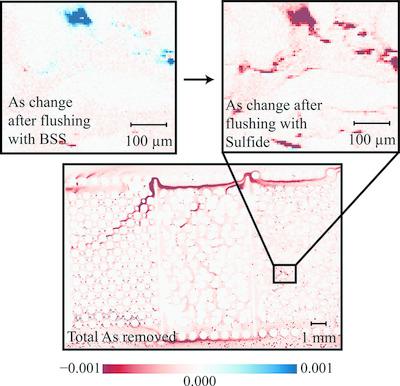当前位置:
X-MOL 学术
›
J. Synchrotron Radiat.
›
论文详情
Our official English website, www.x-mol.net, welcomes your
feedback! (Note: you will need to create a separate account there.)
Development of a novel microfluidic device to study metal geochemistry in situ using X‐ray fluorescence microprobe spectroscopy
Journal of Synchrotron Radiation ( IF 2.4 ) Pub Date : 2021-01-15 , DOI: 10.1107/s1600577520016239 Michael A. Chen , Benjamin D. Kocar
Journal of Synchrotron Radiation ( IF 2.4 ) Pub Date : 2021-01-15 , DOI: 10.1107/s1600577520016239 Michael A. Chen , Benjamin D. Kocar

|
The study of in situ microscale biogeochemical processes represents a major challenge in the environmental sciences. The combination of microfluidic devices with X‐ray fluorescence microprobe spectroscopy may address this need, but typical materials used in these devices attenuate the X‐rays needed to analyze key elements of interest, such as Fe or As. In this work, a method is presented for fabricating an etched silicon microfluidic device that is sealed with a 30 µm thin glass window that is sufficiently transparent for X‐ray fluorescence microprobe spectroscopy. The capabilities of these devices for X‐ray microprobe spectroscopy are demonstrated using an Fe (hydr)oxide solid that is loaded with As and then infused with sulfide, on beamline 4‐BM at NSLS‐II, resulting in time‐variant Fe precipitation reactions and As sorption. Key results include in situ X‐ray fluorescence time‐series maps of Fe, As and a Br flow tracer, as well as spot XANES at both the Fe K edge and As K edge. Additionally, multiple energy mapping is used to examine the spatial speciation of As over time. The results of this work clearly demonstrate the capabilities of this novel microfluidic system that can be analyzed using X‐ray fluorescence microprobe spectroscopy and can be made to study a wide range of complex microscale geochemical systems.
中文翻译:

使用X射线荧光微探针光谱学开发新型微流体装置以就地研究金属地球化学
原位研究微型生物地球化学过程代表了环境科学中的一项重大挑战。微流控设备与X射线荧光微探针光谱技术的结合也许可以满足这一需求,但是这些设备中使用的典型材料会衰减分析感兴趣的关键元素(例如Fe或As)所需的X射线。在这项工作中,提出了一种制造蚀刻的硅微流体器件的方法,该器件用30 µm的薄玻璃窗密封,该玻璃窗对于X射线荧光微探针光谱学是足够透明的。在NSLS-II的射线束4-BM上,先用载有As并然后注入硫化物的Fe(氢)氧化物固体证明了这些设备用于X射线微探针光谱的功能,从而导致了Fe随时间变化的沉淀反应和作为吸附。主要结果包括Fe,As和Br流动示踪剂的原位X射线荧光时间序列图,以及Fe K边缘和As K边缘处的XANES点。此外,多重能量映射用于检查As随时间变化的空间形态。这项工作的结果清楚地证明了这种新颖的微流体系统的功能,可以使用X射线荧光微探针光谱法对其进行分析,并且可以用来研究各种复杂的微尺度地球化学系统。
更新日期:2021-03-04
中文翻译:

使用X射线荧光微探针光谱学开发新型微流体装置以就地研究金属地球化学
原位研究微型生物地球化学过程代表了环境科学中的一项重大挑战。微流控设备与X射线荧光微探针光谱技术的结合也许可以满足这一需求,但是这些设备中使用的典型材料会衰减分析感兴趣的关键元素(例如Fe或As)所需的X射线。在这项工作中,提出了一种制造蚀刻的硅微流体器件的方法,该器件用30 µm的薄玻璃窗密封,该玻璃窗对于X射线荧光微探针光谱学是足够透明的。在NSLS-II的射线束4-BM上,先用载有As并然后注入硫化物的Fe(氢)氧化物固体证明了这些设备用于X射线微探针光谱的功能,从而导致了Fe随时间变化的沉淀反应和作为吸附。主要结果包括Fe,As和Br流动示踪剂的原位X射线荧光时间序列图,以及Fe K边缘和As K边缘处的XANES点。此外,多重能量映射用于检查As随时间变化的空间形态。这项工作的结果清楚地证明了这种新颖的微流体系统的功能,可以使用X射线荧光微探针光谱法对其进行分析,并且可以用来研究各种复杂的微尺度地球化学系统。











































 京公网安备 11010802027423号
京公网安备 11010802027423号